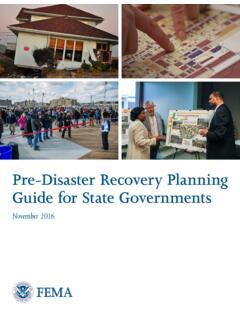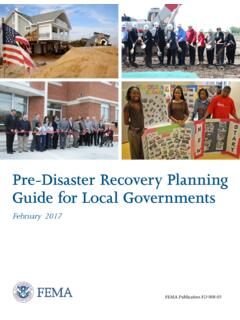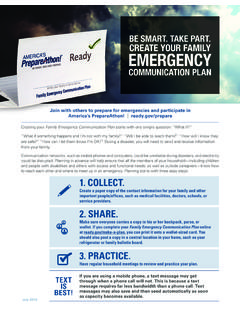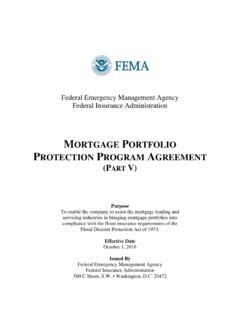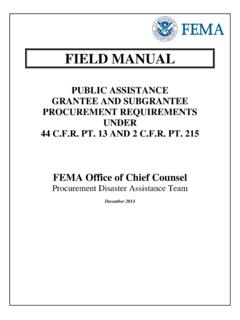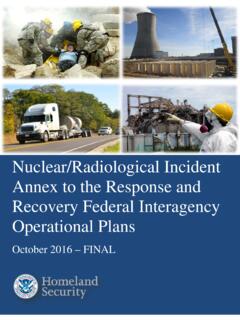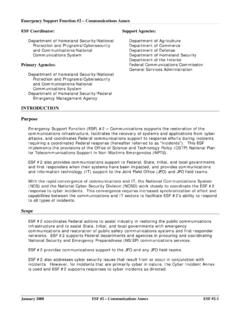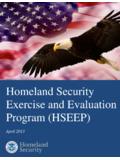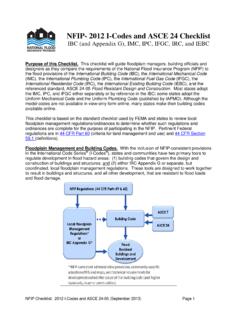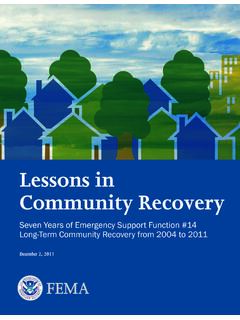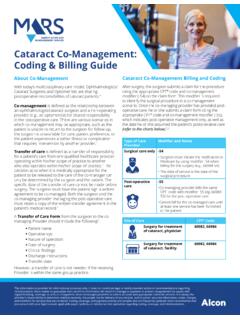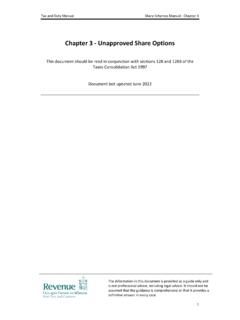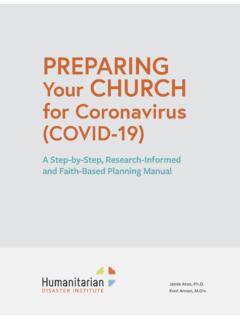Transcription of Debris Estimating Field Guide - FEMA
1 Debris Estimating Field GuideFEMA 329 / September 2010 fema Debris Estimating Field GUIDECONTENTSI ntroduction1 Debris Estimating Considerations4 Debris Estimating Methods5 Ground Measurements6 Buildings and Residences9 Conversion Factors13 Aerial Estimates13 Computer Models15 Safety17 fema Debris Estimating Field GUIDE1 The Robert T. Stafford Disaster Relief and Emergency Assistance Act, (Stafford Act), Public Law 93-288, as amended, 42 5121, et seq., authorizes the Federal Emergency Management Agency ( fema ) Public Assistance (PA) Program to award Federal funding to State and local governments, Federally recognized Tribes, and certain eligible private non-profit organizations in order to assist them in their disaster response and recovery activities.
2 Under the Stafford Act, fema provides PA program grant funding for Debris clearance, removal, and monitoring efforts to eligible applicants following a Presidential emergency or disaster declaration. Timely, accurate, and consistent estimates of Debris quantities and types are an important aspect of fema Debris operations. fema uses Debris estimates obtained during Preliminary Damage Assessment (PDA) activities to provide part of the basis for its recommendation as to whether a disaster declaration should be approved. fema also uses PDA Debris estimates to identify potential needs for Mission Assignments for Technical and Direct Federal Assistance to PA applicants. The fema PA Debris Task Force Leader (DTFL) relies on PDA Debris estimates to make informed decisions concerning staffing levels, required technical expertise, organizational INTRODUCTIONFEMA Debris Estimating Field GUIDE2structure, and geographic distribution of the fema PA Debris Task Force.
3 The DTFL also uses Debris estimates to update senior fema management, the State, applicants, and the general public regarding the status of Debris operations. Finally, the fema PA Debris Task Force relies heavily on accurate Debris estimates to define eligible scopes of work during project formulation and Project Worksheet development for an applicant s Debris -related 407(e) of the Stafford Act establishes deadlines for fema to provide funding for Debris removal activities. The complete text of Section 407(e) is as follows:(e) Expedited payments (1) Grant Assistance In making a grant under subsection (a)(2), the President shall provide not less than 50 percent of the President s initial estimate of the Federal share of assistance as an initial payment in accordance with paragraph (2).
4 (2) Date of Payment Not later than 60 days after the date of the estimate described in paragraph (1) and not later than 90 days after the date on which the State or local government or owner or operator of a private nonprofit facility applies for assistance under this section, an initial payment described in paragraph (1) shall be Debris Technical Specialists must work closely with the State, Tribal governments, and applicants to achieve reasonable, consensus- based Debris Debris Estimating Field GUIDE3 This document is intended for use as a supplement to the Public Assistance Debris Management Guide ( fema 325) to ensure that fema Debris Technical Specialists apply a consistent methodology to obtain accurate Debris estimates in accordance with PA program eligibility Debris Estimating Field GUIDE4 The DTFL should clearly define the accuracy and precision requirements for disaster Debris estimates in the fema Debris Operations Strategy to achieve the desired results.
5 A key consideration in defining estimate requirements is how the estimate will be used, , if a Debris estimate is only used for a PDA, the level of accuracy and precision required is less than that required to develop a Project Worksheet. The formulas, assumptions, and conversions used by the fema Debris Task Force must be applicable to the circumstances of the disaster and be consistently Debris Technical Specialists should confirm with the DTFL which formulas, assumptions, and conversions should be used and remember to check all work for accurate math and units of measure. fema Debris Technical Specialists should document the basis of the Debris estimate, including the methodology and equipment used, formulas, assumptions, and conversions to support decision equipment and resources required will depend on the type of Estimating method used.
6 Examples of possible equipment include cameras, measuring tapes, and GPS units. Examples of possible resources include the personnel required to develop the estimates, Geographic Information System (GIS) data, aerial photos, and Debris modeling Estimating CONSIDERATIONSFEMA Debris Estimating Field GUIDE5 There are several methods available to develop Debris estimates. The DTFL should select the method based on the accuracy, precision, and schedule requirements of the operation, and by the availability of resources such as personnel and equipment. Ground measurements of Debris can be taken to develop estimates, using visual observation and detailed data collection with equipment such as measuring tapes and GPS units Aerial and satellite photographs of areas taken before and after the disaster event may be used to estimate Debris quantities and types, based on the structures, features, and Debris observed in the photos Computer models, including those developed by the Army Corps of Engineers (USACE)
7 And FEMAThe fema Debris Task Force may use a combination of Estimating methods, if necessary, to meet the requirements of the Estimating METHODSFEMA Debris Estimating Field GUIDE6 GROUND MEASUREMENTSThe basic steps and considerations when completing Debris estimates using ground measurements include:1. Define the area covered by the Debris estimate:a. Divide the area, as needed, to differentiate differences in Debris types and amounts, which may be influenced by items such as differences in land use ( , rural versus urban) within the area b. Division of the area into sections should take into account how the applicant may have divided the area into sections, either for the purpose of developing Debris estimates or for planning the execution of Debris removal activities2.
8 Determine whether comprehensive Debris measurements ( , street-by-street) or measurement of a representative sample is appropriate for the estimate requirements3. Identify and obtain the personnel and equipment necessary to complete the estimate:a. The number of personnel used depends on the area to be covered, ease of access to the area, schedule to complete the estimate, and availability of personnel resourcesb. The equipment used for ground measurements commonly includes a digital camera, measuring tape or roll-off wheel, calculator, sketch pad and note fema Debris Estimating Field GUIDE7paper, maps, GPS unit, laser rangefinder, and equipment needed for logistics and safety ( , vehicle, cell phone, first aid kit)4.
9 Engage the State and applicant in the ground measurement process:a. The applicant is generally a source of information used for the estimate, such as locations of public property and rights-of-way, and planned Debris removal activitiesb. Proactively engaging the State and applicant will also facilitate achieving earlier, consensus- based Debris considerations regarding Debris estimates based on ground measurements include: Ensure the measurements include all eligible Debris Eligible Debris may include disaster-generated Debris located in the yards or inside of residences that has not yet been placed on the right-of-way Limbs hanging in trees that will likely be placed on rights-of-way should be included Flood disasters may produce personal property Debris ( , household furnishings, clothing) that may still be in residences at the time of the Debris estimateFEMA Debris Estimating Field GUIDE8 The estimate should not include any ineligible Debris ( , old tires, residential construction materials, and white goods awaiting disposal prior to the disaster event)
10 , but ineligible Debris (estimated quantity and location) should be noted so that it can be properly addressed during project formulation Recognize that Debris may undergo changes in volume during the handling process Flood-deposited sediment may be naturally compacted in place, and the volume may increase when it is removed Leafy vegetative Debris located on public property and rights-of-way may experience a significant reduction in volume when it is mechanically loaded into trucks One acre of Debris 10 feet high converts to 16,133 CY 43,560 SF x 10 FT = 16,133 CY 27 fema Debris Technical Specialists should approximate the volume of Debris piles using cubes when conducting ground measurements.
